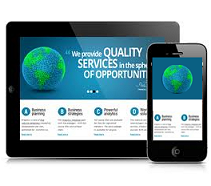Whether you’re planning a new website or 
thinking about updating an existing one,
you’ve got an important decision to make up front:
Should your site be static or dynamic? The answer
will drive the design, implementation and operation
of your site as well as how much it will cost to
create and maintain. In fact, no serious work can
be done on your new site or redesign until
you’ve made a decision.
A static site, as the name suggests, is one that changes infrequently.
It’s not unlike a company brochure that, once printed, is difficult
to change without a lot of work and money. It does not change based
on the interactions or interests of the visitor.
Any updates require not only the new content but also changes to the code. That’s because each page on the site contains both the code and the content. Static sites are relatively inexpensive to set up and, as long as changes are usually infrequent, cheap to maintain. However, visitors may not return because the content is rarely updated.
Dynamic sites, on the other hand, can be changed easily and frequently. They’re powered by a layer of software called a content management system (CMS). Pages consist only of code that tells a server where to find the content, which is typically stored in a database. To make a change, the user uploads the content to the database and controls the appearance via an easy-to-use administration page. The CMS takes care of updating Web pages. CMS-powered sites take more effort to set up, but they are easier to maintain and update. Also, visitors are more likely to return for the fresh content.
Here’s a closer look at the differences between static and dynamic, CMS-driven websites:
Implementation
Static sites can be created very easily and inexpensively. You only need a text editor and an FTP client to push your HTML pages and content to a Web server. Of course, the pages must be correctly coded or else there will be broken links and other problems. But this is not a difficult task if the site consists of only a few simple pages.
CMS-powered sites are more difficult to set up because of the addition of a database and the software that enables simple administration and other features. Once the underlying software and hardware are installed, you must determine what modules to use to give your site features. There are thousands to choose from. For example, if you are an e-business, you’ll want to include modules for handling customer transactions, displaying products and searching within the site. Most content management systems include modules for search engine optimization. The setup of a dynamic, CMS-driven site may sound daunting, and it can be for those not familiar with the process. Once this one-time job is completed, content updates are simple and quick.
Administration/Maintenance
Once a site is running, it’s got to be maintained. Your organization may have a new event or product it wants to announce to the world. With a static site, each page needs to be updated to incorporate the new content. At the very least, this involves opening each page, changing HTML links and uploading new images or other media. Users need to understand HTML or else risk breaking a page or the entire site.
This is the area where CMS shines. Users do not need any knowledge of HTML. Instead, they visit an administration page from which they can upload new content and make changes to existing text much like they would in a word processor. In most CMS sites, this posts the content to a database. The site then automatically updates to reflect the changes.
Search Engines
If you are a business, you want potential customers to visit your site. But if they are not aware of your business, how can they find you on the Internet? The answer: search engines. How your site ranks in search results for keywords is determined by algorithms unique to each search engine. With static sites, you must know exactly how to sprinkle keywords throughout the body text and meta tags. Most content management systems take care of this work for you. You need only enter your keywords once, and the CMS will make sure that your pages will get the attention they deserve from search engines.
There’s another advantage to dynamic sites: Search engine algorithms give preference to sites that are frequently updated. Search engines such as Google want to direct their customers to the freshest and most relevant content, and dynamic, CMS-powered sites do exactly that.
Redesign
Eventually, you will want to update more than just the content of your website. You’ll want to give the site a new look and feel. If you have a static site, once you’ve settled on a new design, every page on a must be changed to incorporate the new look. If your site consists of only a few pages, this is not a problem. If it’s hundreds of pages, though, you might as well start from scratch.
CMS-powered websites, on the other hand, are much more easily updated. The design work only needs to be done in one place – the administration page. With a few clicks, all the changes required by your new design will be instantly propagated across the site.
Ultimately, the answer to the question of static or dynamic depends on your goals for the website. If your content won’t be changing and you wish only to present information to existing customers, a static website may be the best choice. But if you expect frequent updates and high rankings in search engine results, a dynamic site powered by a content management system is the way to go. It will take more time and effort to set up than a static site, but it will pay off in the future with simpler updates and higher visibility.
